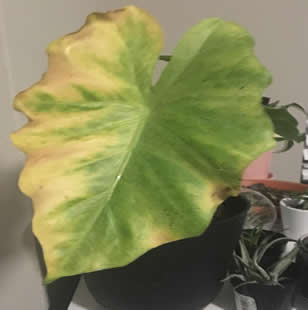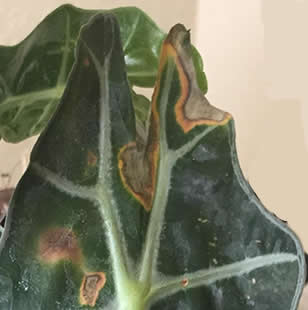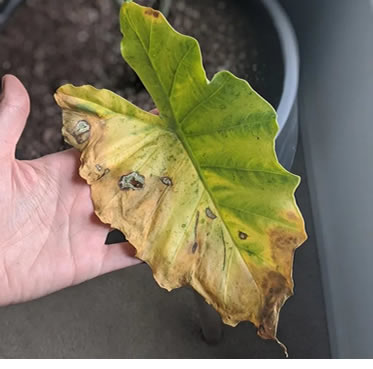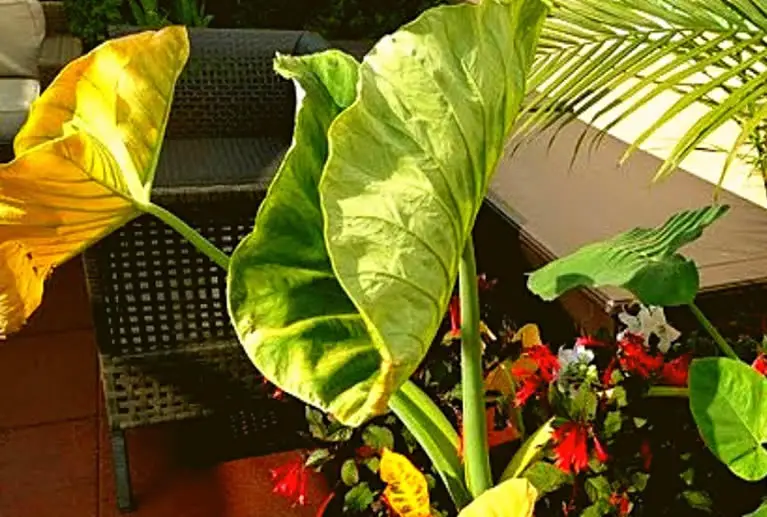Elephant ears are popular plants that can be grown outdoors in the garden or in pots and also grown as an indoor plant. They are usually fairly easy to care for and when things are not going quite right with the plant it will let you know. The leaves of an elephant ears are the first to show signs of problems and can even indicate that the plant is dying.
Table of Contents
What You Should Do When Elephant Ear Leaves Die
When elephant ear leaves start dying the first thing you should do is determine what is causing the leaf death.
Direct sunlight, insufficient light, disease, pests, lack of water and lack of nutrients can all cause leaf death but luckily each is each to spot.
Once you identity the cause it is easy to apply a cure.
What dying elephant ear leaves means for your plant
Although one leaf on your elephant ear plant is not usually a cause for concern, excessive leaf death should be something to take very seriously.
It is natural for old leaves to wither and die on any plant but when you see signs of excessive leaf death, or death during a period when the plant should be growing, you must take action.
Below are two common signs seen in dying elephant ear leaves that indicate your plant may need your immediate attention.
What it means when elephant ears turn yellow
Leaves turning yellow on an elephant ear plant is one of the more common problems, especially for those plants that are grown in pots indoors.
When leaves on an elephant ear plant turn yellow it is often a sign that there is a problem with the plant and you must take action to determine if your plant needs attention.
It is much more common to see yellowing elephant ear leaves on an indoor plant than it is to see it occurring on an outdoor plant because an outdoor plant. You will see why shortly.

Although elephant ears do require sufficient light to grow well, they do not react well to too much direct sunlight.
One of the biggest mistakes people make with their indoor plants is giving them too much direct sunlight. It is a myth that all plants need a lot of light.
Sure, some plants will thrive on direct sunlight, such as the perennials Agastache and eryngiums, but most houseplants do not require it and will react badly to it.
Too much direct light can harm all your indoor houseplants and elephant ears are not an exception.
So, when your plant’s leaves start to turn yellow they are dying and your first action should be to move your plant away from direct sunlight.
Also consider adding some fertilizer to give the plant the much needed nutrients it will need to recover.
Use an appropriate fertilizer with with a 20-10-20 ratio, like this one from Amazon.
Never use coffee grounds on your elephant ear plants for the reasons I covered in this article.
Once you have relocated your plant cut back the yellow leaves and allow the plant time to recover. You may have to wait until next spring for the leaves to return.
Your next step will depend on whether there are other contributing factors involved in the yellowing of the elephant ear leaves.
Review the rest of the information in this article to determine if there are other factors involved that may be contributing to the yellowing leaves. Then make any appropriate changes to the plant’s environment and conditions if necessary.
If you find that your plant has more than adequate conditions and is in an ideal environment, and it is not showing any sign of disease, then the yellowing leaves are almost certainly just an indication that the plant is going dormant for the season especially if it is past growing season.
If it is growing season then you need to rethink your processes for checking the plant for problems.
Recheck it and apply the most appropriate remedy.
Consider repotting the plant in a new container with new soil.
What it means when elephant ear leaves start turning brown
Browning leaves on an elephant ears plant usually start at the edges of the leaf (though not always). Again this is often a sign of too much direct sunlight.
Strong sunlight can burn the leaves of the plant leading to “leaf scorching”.

So, more often than not brown spots forming on the leaves of elephant ears can be a reaction to too much direct sunlight.
Think of it as a type of “sun burning” happening on the leaf.
Move the pant to a location where it still receives sufficient light but where it is not in the path of sustained direct sunlight i.e. for an indoor elephant ear plant make sure it is not placed beside a window that gets direct sunlight.
Although too much direct sunlight can be a cause for browning leaves, especially at the edges, it can also be an indication of disease or a pest problem.
Read the information below and take appropriate steps to protect your plant if this is the case.
Causes For Dying Elephant Ear Leaves And Steps To Take
Below are common causes for dying elephant ear leaves.
Read through the following information to identify the most possible cause for your plant’s problems.
Do not be afraid to apply more than one remedy as your plant may be suffering from more than one problem.
However, do not apply every solution in a vain attempt to treat your plant as this could cause more problems in the long run. For example, over-watering your plant will lead to a dropping of the leaves and a weeping of the leaves.
Likewise, moving your plant to a darker location may deprive it of light rather than protecting it from leaf scoring.
Only apply the solutions that best fit your particular plant and its environment.
Too much direct sunlight can cause leaf death
As I have already mentioned earlier in this article, too much direct sunlight can burn the leaves of an elephant ear plant leading to a yellowing of the leaves or causing brown spots to form on the leaves.
Although you should never deprive your plant of light, direct sunlight is not good for elephant ears. So, check the location your plant to ensure it is not get sustained direct sunlight.
A little direct sunlight for short periods should not be cause for too much concern but if your leaves are becoming discolored and dying this should be the first thing you check and the first thing you fix.
Move your plant away from places that get direct sunlight but that are still naturally well-lit.
Lack of light can kill leaves
Just as an elephant ear plant can be negatively affected by too much direct sunlight it can also be harmful to give the plant too little light.
Dying leaves can be an indication that your plant is not getting enough light.
 Apart from obvious clues such as dim or dark and murky environment a key sign that your elephant ear plant is getting insufficient light can be seen in the stalks.
Apart from obvious clues such as dim or dark and murky environment a key sign that your elephant ear plant is getting insufficient light can be seen in the stalks.
Lack of light leads to weak stalks that find it difficult to hold the weight of the leaves.
So, if you see brown leaves dropping from weak stems this is a strong indication that your plant is not getting enough light.
Move the elephant ears to a brighter location ensuring you do not place the plant in direct sunlight.
Lack of water leads to leaf loss
As I covered in a previous article elephant ears are a high water plant.
Elephant ears require a lot of water and, if grown indoors, will likely need more watering than most of your other indoor plants.
Even outdoor elephant ear plants may require additional watering if they get less than 1 inch of water per week.
Are you ensuring your indoor elephant ears plant is getting 2 – 3 inches of water per week?
As a rule-of-thumb ensure the plant soil is always moist and never dries out.
This does not mean you should saturate the soil.
Just keep it moist enough that if you place a finger on it some of the soil will stick to your finger.
Incorrect humidity and temperature can kill leaves
Elephant ears are tropical plants that require a warm and humid environment.
Maintaining good humidity and warm temperatures are essential for healthy, large leaf growth.
If your elephant ear leaves are dying it may be due to cold conditions and/or overly dry conditions. Just as elephant ears love to drink water they also love getting that water from the air around them.
Hence the need for fairly high humidity around the plant.
Misting your plant daily is a great way to maintain humidity levels around elephant ear leaves.
You can also place the plant’s pot on a saucer that is filled with water and pebbles to help maintain good humidity levels.
Obviously the temperature should not be too cold.
For indoor plants this is not usually a problem because their human owners will keep their homes at temperatures that are more than adequate for elephant ears.
Insufficient nitrogen and nutrients deprive leaves of food
Elephant ears do not only require a lot of water, they are high feeders that require a lot of nutrients as well.
Elephant ears require regular fertilization.
It is a good idea to fertilize your plant once per month during the growing season to ensure you maintain the correct nitrogen levels in the soil (20%) and keep the plant well fed with nutrients.
An elephant ear plant thrives in a nitrogen rich soil and will respond best to a nitrogen rich fertilizer with a 20-10-20 ratio, like this one from Amazon which has been formulated specifically for elephant ears or this one from Master Blend.
Pests can attack and kill leaves
Insects can attack both outdoor and indoor elephant ear plants.
Mealybugs, mites and common aphids love nothing better than to eat away at elephant ear leaves and suck them dry of their sap.

The easiest way to deal with these little pests is to wash them off the plant with slightly-soapy lukewarm water.
For the easy option you can use a plant-friendly insecticide spray to spray the leaves and stalks.
I personally prefer to use an organic soap that I simply mix with water and apply with a cloth.
This is not only a cheaper option, because the soap lasts much longer than the spray, and the soap also has multiple uses.
Additionally, because you must use it with a cloth (to wipe the plant clean) I find it is much more effective simply because I get very hands-on with the plant and thus get to inspect every inch of it to ensure it is cleaned.
Although using an insecticide spray is by far the easier and quicker option I have found that it doesn’t always eliminate a pest problem on the first attempt.
I’ve never had to use soapy water and cloth more than once unless the plant has become reinfected by a new infestation.
Disease can cause leaf death
Fungus is the biggest problem for elephant ears when it comes to disease.
More often than not the leaves of an elephant ear will turn brown, especially around the ears, before they die when disease attacks the plant.
If you identify fungus as the problem behind the death of the elephant ear leaves you must take immediate action.
The faster you can resolve the situation the better chance you have of not just saving the plant but also saving the existing leaves on it.
Elephant ear plants with a fungus problem will respond best to a copper fungicide.
You may also want to seriously consider repotting the elephant ear plant in a new pot with new soil.
Dispose of the old container or make sure you wash it thoroughly before using it with another plant.
How To Save A Dying Elephant Ear Plant
Believe it or not death is not always the end. At least as far as appearances go.
If your elephant ear plant appears to be dead do not uproot it and throw it away.
It may be possible to revive it, and trying to revive is certainly worth the small effort it takes.
Cut the main stem of your elephant ears and plant it into another pot or directly into the ground and chances are it will grow a new plant.
It can be beneficial to add rooting hormone to it before potting as this will give it a better change of rooting and growing into a new plant.
I usually dip the end of the stalk that will be placed in the soil into a rooting hormone gel before dipping it a second time into a rooting hormone powder
as I find this gives the cutting a much better chance of propagating.

